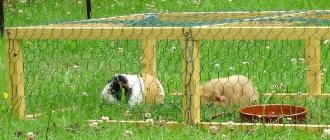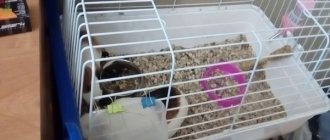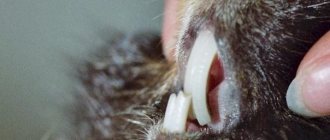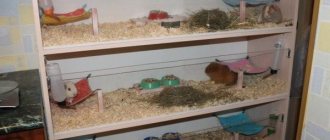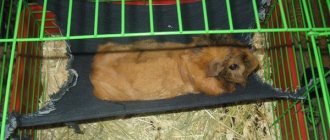Guinea pigs are calm and lazy creatures who spend most of their time relaxing rather than running and frolicking. Therefore, a soft and cozy hammock will be a real gift for a small pet. You can buy such an accessory at a pet store, or you can make a hammock for your guinea pig with your own hands. Making this item will not require special skills from the owner, and the process of sewing a hammock itself is quite exciting and interesting.
Types of hammocks for guinea pigs
Before sewing a hanging lounger, the owner should decide on its location, as well as the model of this accessory.
Hammocks come in three types:
- straight;
- corner;
- in the form of a house.
A straight hammock is hung in a cage, attached between the side walls, so it takes up a lot of space. Such a bed is made if the animal’s home is large and spacious.
For a small cage, a corner hammock would be appropriate, as it is more compact and takes up a small area.
The accessory in the form of a house also does not take up much space and is suitable for small cages.
Necessary materials for sewing a hammock
To make a comfortable hammock for a guinea pig at home, you must first prepare all the necessary materials and tools.
For sewing you will need:
- a piece of thick fabric. Old unwanted jeans or a frayed blanket will work perfectly for this purpose;
- flannelette, fleece or synthetic padding fabric for the layer;
- measuring tape (you can use a ruler);
- scissors;
- skein of thread;
- pencil (marker);
- needle;
- cardboard (if you plan to make a hammock house);
- buttons, ribbons for decoration (at the owner’s request).
Important: to attach the product to the bars of the cage, use strong ropes or special carabiner clips.
Making a rectangular hammock
The easiest way to sew a straight, rectangular-shaped bed for your pet is:
- To do this, two rectangular identical pieces, 40-50 centimeters long and 30-35 centimeters wide, are cut from the fabric chosen for the product. From a piece of flannelette or fleece fabric, cut out a piece smaller than the main pattern (approximately 35 by 30).
- The edges of the fabric are sewn together with the wrong side out, leaving one edge unstitched.
- Turn the product right side out. A cut piece of flannel or fleece is inserted inside.
- Sew up the remaining edge of the hammock. You can trim all four parts with an edge to give the lounger a more attractive appearance.
- Holes are made in the corners and ropes or carabiners are threaded through them. The product is securely attached to the cage bars.
Making a corner hammock
Sewing a corner hammock also does not require much time and effort:
- First you should measure the distance between the corner of the cage. Then two identical isosceles triangles are cut out of the fabric. The long side of the segment should be at least 50-55 centimeters, the short sides - 40-45 centimeters.
- Between the prepared halves, lay a cut piece of triangular-shaped fleece or padding polyester and sew the edges together.
- A carabiner or a piece of thick rope is threaded into each end of the triangle and the product is installed in the corner of the cage.
How to make a hammock house
A hanging hammock in the shape of a house will especially appeal to your guinea pig. After all, in it a little pet can not only relax comfortably, but also take refuge in order to eat his favorite treat.
It will take more time to make than the two previous accessories. But the owner’s reward for his efforts will be the cute rodent’s joy and delight at such a wonderful gift.
- Patterns of different sizes are made from the selected dense fabric.
- The longest and widest part serves as the basis of the future hammock, so it must be at least 130 centimeters wide and 50 centimeters long.
- Then two rectangular parts are cut out, 40 centimeters long and 50 centimeters wide. This will be the “roof” of the hanging lounger.
- The rectangular parts are sewn together with the wrong side out, turned inside out and a piece of thick cardboard inserted inside. Sew the remaining side.
- Cardboard or padding polyester is wrapped in the largest piece of fabric (the base) and the edges are sewn together.
- The base is sewn on both sides to the “roof”.
- The final stage is the pattern of the back wall. This is not necessary, but will make the structure safer for the animal. After measuring the length of the sewn base, cut out two semicircular pieces of fabric, leaving one straight edge. Three sides of the wall are sewn together, a piece of cardboard is placed inside and the remaining edge is sewn up.
- The back part is sewn with the straight side to the roof and the convex part to the base of the product.
- A cozy hanging hammock house for a guinea pig is almost ready. All that remains is to thread the ropes into the corners of the roof of the product, hang it from the top of the cage and invite your pet to a housewarming party.
Suspension
For a hanging house you will need thick fabric about 1.3 meters long and 30 cm wide, scraps of plywood or thick cardboard 25*25 cm, and tape.
- Cut a piece of fabric 60 cm long. Sew on both sides.
- Turn the fabric inside out and insert plywood into the resulting pocket. To make the pig soft and comfortable, you can add a layer of batting or padding polyester on top of the plywood. Sew up the edge.
- Visually divide the main fabric into three parts. Sew the left edge to the left side of the base, and the right edge to the right chamfer.
- Having given the house a square or triangular shape, determine the boundaries of the top. Place tags. Sew ribbons to the marked places.
- Secure it in the desired place in the enclosure.
It is important to know:
Lice eaters in guinea pigs.
If the product will be used for a long period, it is better to attach carabiners to the free edges of the tapes. This will save time for quick removal when cleaning the cage or for washing.
In order for the animal to quickly get used to the new accessory, the hammock can be placed in the animal’s resting place to soak in the odors. A delicacy left in the bed will help you master a new product faster.
Some tips and tricks
The following points should be considered when using a hammock:
- Guinea pigs cannot jump high. Therefore, the hammock should be hung at such a height that the pet can easily climb into it. This rule is also important to follow because a rodent can be injured if it accidentally falls out of a bed located at a high altitude;
- the accessory must be spacious so that the animal feels comfortable and comfortable in it;
- To sew a hanging lounger, choose dense and durable fabric: denim, velor, cotton or fleece. Silk, satin and linen are not suitable for this purpose;
- There should be no threads sticking out from the product. After all, the pet will begin to chew on them, which can lead to tears in the fabric and damage to the hammock;
- If the owner decides to decorate a homemade lounger with buttons or other objects, then he should remember that they need to be sewn very securely to the product. After all, if an animal bites off and swallows a small piece of decor, this can lead to the death of the animal;
- Another important nuance is that guinea pigs have a weak spine. Therefore, the bed should not sag too much so that the rodent’s spine does not bend when it is in it.
- Sometimes animals show no interest in hanging beds and stubbornly ignore them. To accustom your guinea pig to a hammock, you can put his favorite treat there. Or attach the accessory in the place of the cage where the pet likes to sleep, so that the product is saturated with the smell familiar to the animal.
Sewing a hammock for a guinea pig is not difficult at all. A hand-made accessory will not only decorate the cage, but will also become your little pet’s favorite resting place.
join the discussion
Share with your friends
Small rodents with charming eyes and delicate fur have been very popular among Russian and foreign breeders for many years. We are talking about wonderful guinea pigs. Fluffy “pigs” prefer to rest in a comfortable position most of the time. An excellent solution for guinea pig owners would be a hammock made with your own hands.
What types of bedding are there for rodent cages?
The most popular bedding for guinea pigs. Sawdust is sold at a pet store; you can use waste from a sawmill. When choosing a filler, it is better to give preference to larger shavings or sawdust of the middle fraction, since fine dust can harm the health of the rodent.
For the same reason, it is not recommended to use sawdust with artificial flavoring.
Pig breeders choose this bedding because:
- she is soft; Guinea pigs love to dig in it; absorbs moisture; accessible and inexpensive; has an aesthetic appearance; has a pleasant smell.
- do not retain odors; get wet quickly; may cause allergic reactions (itching, sneezing, etc.); sometimes they contain sharp wood chips.
Wood granular filler
This is a filler made from natural materials. It is produced by grinding sawdust, bark, and other wood waste and then pressing it. The particles are glued together using lignin, which is also a natural wood product.
There are many advantages to this type of bedding:
- inexpensive; is used sparingly; convenient to clean; will not harm the health of the animal; retains moisture well; holds unpleasant odors well; smells pleasant of pine; easy to recycle (can be flushed down the drain).
Disadvantages of wood pellets:
- noisy; do not use alone, it is better to pour sawdust on top or lay a PVC mat.
The pig should not be allowed to be on a wet floor. This can lead to pododermatitis, fungus and baldness.
PVC mat
The PVC mat is ideal for pigs as bedding. It must be laid on top of another filler: sawdust or granules. You can purchase bedding in the household goods department. It is easy to care for. It is enough to shake it out and wipe with a damp cloth every day.
Once a week, the bedding should be spun in a washing machine at a temperature of 30 ⁰C on the shortest setting.
Advantages of a PVC mat:
- protects animal paws from dust, sawdust, and hard filler elements; protects food from contamination; does not allow debris to fly away; Availability – easy to purchase, cheap.
The disadvantage of bedding is that piglets can chew it or crawl under it.
Not just any fleece will do. It is necessary to check the quality of the material:
- composition – 100% polyester; the parties are different from each other; There are no pills after washing.
It is better to purchase several replacement sets at once. Immediately after purchase, fleece is washed 2 to 4 times without rinse aid. After washing, moisture permeability will increase and the material will shrink and take on its final size.
The bedding is laid out on the floor of the cage in 2 layers on top of sawdust, granules or other filler, since it will not absorb urine.
- reusable bedding; pleasant to the touch material; aesthetic appearance.
The disadvantage is the difficulty of cleaning, which is complicated by the fact that small debris sticks to the material.
For what?
Unlike decorative rats, a guinea pig has short legs and cannot climb over all kinds of obstacles. Therefore, a hammock is an ideal place for it. It will become an excellent shelter and place of relaxation for the animal after outdoor games. First of all, the breeder needs to know that the animal’s legs and spine are quite weak. In this regard, a high-hanging hammock will only cause inconvenience to your pet.
The animal may make an unsuccessful jump and suffer a serious fracture. The “bed” for fluffy “piglets” should have excellent tension and be fixed between the two walls of the “dwelling”. The most convenient height is 6–8 cm from the floor level.
Naturally, a ready-made hammock can be purchased at any pet store. But for the sake of economy, you can do such a thing with your own hands. In addition, its creation does not require professional skills and knowledge, and the manufacturing process itself is quite interesting and creative.
Our pets love to spend long hours in secluded places. Houses, small shelters, minks, things of the owners, this attracts both large and small pets, because in the wild they need protection. These little animals simply love to be on a hill, surrounded by cozy walls. Guinea pigs are no exception, but you can place a very interesting design for them right in the cage; the owners of these cute animals can equip a hammock for the guinea pig in it. They differ not only in their variety of appearance, but also in the abundance of designs provided for different occasions.
General recommendations for choosing a house for a pig.
It is advisable to provide each guinea pig with its own house; It’s even better to put a couple of houses for each pet to choose from. The houses should be different in color and size, so each guinea pig will have its own quiet “room”.
Do not disturb the pig in the house. This might make her angry. As soon as the pig has rested, it will come out of its shelter and be ready to play. A guinea pig house should not be filled with hay or bedding placed there. It is best to place this building material somewhere near the pet's home. If necessary, the pet will take everything it needs into the house itself. Although pigs can easily get by in the house without it.
You can easily find a large selection of suitable housing in any pet store, but if you wish, you can make a house for a guinea pig with your own hands.
And if you have not yet decided on the breed of guinea pig, be sure to read our article.
Types of hammocks for guinea pigs
When choosing a resting place for their pet, owners may be faced with a variety of choices; before going to the store or starting to make a hammock with your own hands, you should familiarize yourself with their types. Each of them is adapted to different cell sizes and the wishes of the owners.
For guinea pigs, you can choose one of three types of hammocks:
- Straight. This type is intended for large cages in which you can hang it from one wall to another, but such a hammock will take up a large amount of space.
- The corner one takes up much less space and is suitable for smaller cells. You can place it in any convenient corner without affecting the rest of the cage.
- A hammock house will be the ideal solution. It performs two functions at once, moreover, it has smaller dimensions than a straight one, but the pet will like it much more.
Necessary materials for sewing a hammock
Almost anyone can make a cozy hammock for their guinea pig, and sewing it requires very simple materials that can be found in any home. Many manufacturers use inferior fabrics when making guinea pig hammocks, so a homemade option can be considered ideal. Having prepared everything you need, you can quite simply create the ideal home for your pet. What is required for this design?
- A suitable piece of fabric of any kind, you can use pieces of old clothes, bed linen, curtains, but the main thing is to take into account the density of the fabric and its softness so that the rodent is comfortable.
- A softer fabric for lining, you can use a piece of fleece or old home clothes. Synthetic padding or regular cotton wool filling is also suitable.
- Measuring sewing tape or ruler.
- Sharp scissors.
- Threads and a piece of rope.
- Marker, pencil or piece of soap.
- Sewing needle.
- For the hammock house you will also need cardboard.
- Decorative elements, optional.
Fabric selection and tool kit
First of all, you need to decide on the choice of material for your future hammock. Dense material that does not spread and does not absorb odors is best suited for these purposes. The fact is that furry animals love to mark their territory.
To make an accessory, take denim, cotton or fleece. Please note that silk and satin fabrics are not recommended. In addition, you should not use synthetic materials. The fact is that synthetics, when in contact with animal fur, generate static electricity. In this case, the hairs “stand on end” and the guinea pig experiences discomfort. You will also need strong ropes to attach the hammock. They can be made from leftover fabric or braid.
To sew a hammock you will need the following set of tools:
- sharpened scissors;
- a set of needles and threads;
- sewing machine (optional);
- felt-tip pen or pencil (bright colors);
- cardboard (for the hammock house);
- buttons and ribbons for decoration;
- fabric for filling (cotton wool, padding polyester or fleece);
- tape measure or ruler.
Making a rectangular hammock
In order to make a rectangular hammock for a guinea pig, we will need:
- Cut out two pieces of cotton, denim or other dense fabric, approximately 40x40 or 35x35 cm in size. From the warmer fabric prepared for lining, cut out a smaller piece, about 5 cm.
- Sew the edges wrong side out, leaving one unstitched.
- Turn the product inside out, putting a piece of lining inside; you can use fleece or thick synthetic padding.
- Sew the hammock, finishing the rest of the outside with ribbon or other decoration, if desired.
- Punch holes around the edges, sew them, or use button rings and thread string through them to form loops for placement in the cage.
Sewing a straight hammock
There is another way to make a hammock for a guinea pig at home. For the straight option, denim or fleece fabric is suitable. Old jeans are a great option. You need to cut two pieces of fabric from the trouser leg, measuring at least 30x35 cm. You can put a little synthetic padding between them for greater coziness and comfort. Next, sew the ends together with a strong seam and sew ropes in the corners to secure the product to the walls of the cage.
Making a corner hammock
The method of sewing this type of hammock is not very different from the previous one, but it requires a little more effort in calculating the distance. It is worth considering not only the length of the two sides, but also the edge of the triangle. Starting to manufacture the product:
- Measure the distance in the cage to create the ideal angle. Measure both sides, transfer them to the fabric and connect with the third. Try to take into account the size of the hammock for your cage so as not to take up most of it.
- Before sewing all sides of the hammock, place insulation material inside. When cutting out a piece of fleece or padding polyester, make it slightly smaller than the main pieces, taking into account the size of the seam and the density of the fabric itself.
- Make holes on all sides of the triangle, inserting loops of rope or carabiners into them.
- Place the hammock in the cage, tying it on both sides and securing it in the middle.
How to make a hammock house
Making a hammock house will take a little more effort than the previous ones, however, such a hammock will definitely appeal to an animal that loves to live in shelters. The guinea pig will be able not only to sleep in it, but also to spend most of his day, having lunch with something tasty and taking cover in case of noise.
- First of all, you should make two different patterns from dense material, for the hammock itself and its roof.
- The largest pattern is intended for the base of the hammock; its dimensions will be from 110 cm in width and 45 in length. Calculate the preparations based on the size of the cage and the size of your pet.
- Next, cut out two rectangles proportional to the base, designing them as a roof for your hammock. The size will be approximately 50 by 40 cm.
- Sew the rectangular blanks in the same way as for the rectangular hammock, leaving one edge unstitched. Instead of fleece, place a piece of thick cardboard there, pre-cut 5 cm smaller than the fabric blanks.
- A cardboard base is also included in the base; you can put a padding polyester lining on top so that the guinea pig is comfortable in its home.
- Connect the roof and base by stitching both parts of the structure.
- If desired, after making the base, you can make the back wall of the house by measuring the finished structure and fitting semicircular patterns to it. Seal it with a cardboard base, making it slightly convex.
- Carefully sew the back cover to your house, with the convex side facing out.
- We make holes on four sides of the roof; you can cover the holes so that the fabric does not wear out. Next, we thread rope loops or carabiners through them.
- We install the finished structure into the cage.
Plush house for rodents KIMHOME PET (2 sizes, 2 colors)
Seller's reliability: excellent!
Delivery within Russia: free!
Review #1: Fast delivery. Everything is good, as in the picture. There are no threads. I think the pig will be very warm there.
Review #2: Wonderful house. Came to Tula in 15 days. There is no smell, the threads do not stick out. Mattress with zipper, washable. Only very big for a 2 month old pig. But that’s okay, for growth.
Review #3: Satisfied! Soft, warm, what else do you need? I moved all the food there.
How to train a guinea pig to a hammock
Almost all rodents, and just animals accustomed to hiding in secluded places, love sheds, houses and other cozy structures, but some of them may react very coldly to a new thing in the home, and you will need to accustom the guinea pig to a hammock. If your pet ignores the hanging bed or has stopped using it, you can put something tasty in it. Perhaps the animal simply did not pay attention to it, but, having seen something interesting, it will discover all the advantages of the new toy.
If you have recently gotten yourself a pet, you should not try to install anything new in the cage; let the guinea pig get used to your apartment, and then pamper it with toys. Wait a couple, three months. The animal will calm down and will be able to accept a new guest into the cage.
You shouldn’t hang it too high from the floor of the cage; these rodents have small and short legs, and it will be completely inconvenient for them to climb onto a high structure. You should not make the product overhang too much; these animals have a rather fragile spine, not adapted to being in such places. Also, when decorating a hammock with small items, take care of the strength of the fasteners so that a rodent does not eat them. In any case, even when preparing a bed for your pet, you should think about his health.
Carrying - just in case
This element is used to transport an animal. Guinea pigs are easily stressed, they get scared quickly, and the road is a serious irritant for them. That is why you will need to take care of a reliable shelter for your pet. Pet stores offer a ready-made cardboard version with holes for air supply. But a plastic container is more reliable: it is durable and is a more practical option.
The main purpose of a plastic carrier is to minimize the stress of travel.
Hammock care
Like any accessory, a hammock also requires periodic maintenance to keep it clean and hygienic. It should be washed approximately once every one to two weeks, as it gets dirty. If a rodent begins to drag its food into it or defecate, you should stop using it altogether.
For washing, you should use products without fragrances or odors, you can use baby shampoo or soap. For more thorough cleaning, regular laundry or tar soap that does not have chemical fragrances is also suitable.
Make sure that the edges of the fabric are not frayed to avoid threads getting into the guinea pig's body. These little animals love to chew on ropes, so for hanging, it would be better to use carabiners or a thicker rope that does not have protruding ends.
A homemade guinea pig hammock is the perfect solution to make your pet's cage cozy and functional. Making such a product will take very little time, and the quality will differ little from that purchased. However, if you wish, you can purchase it in the store. Modern pet stores offer a variety of types of houses and hammocks for different animals, both small and large.
Special toilet fillers
Not all types of special litter for toilets are suitable for a guinea pig cage. Only cellulose or wood based bedding can be used. Your pet may try to eat the litter, so clumping formulations are not suitable. It is acceptable to use silica gel litter if the pig is not interested in it as a dental trainer or treat. It is recommended to cover such a filler with a PVC mat or other bedding.
Advantages of the filler:
- absorbs moisture well;
- eliminates unpleasant odors;
- easy to clean.
Flaws:
- high cost;
- dangerous if your pet eats it.


